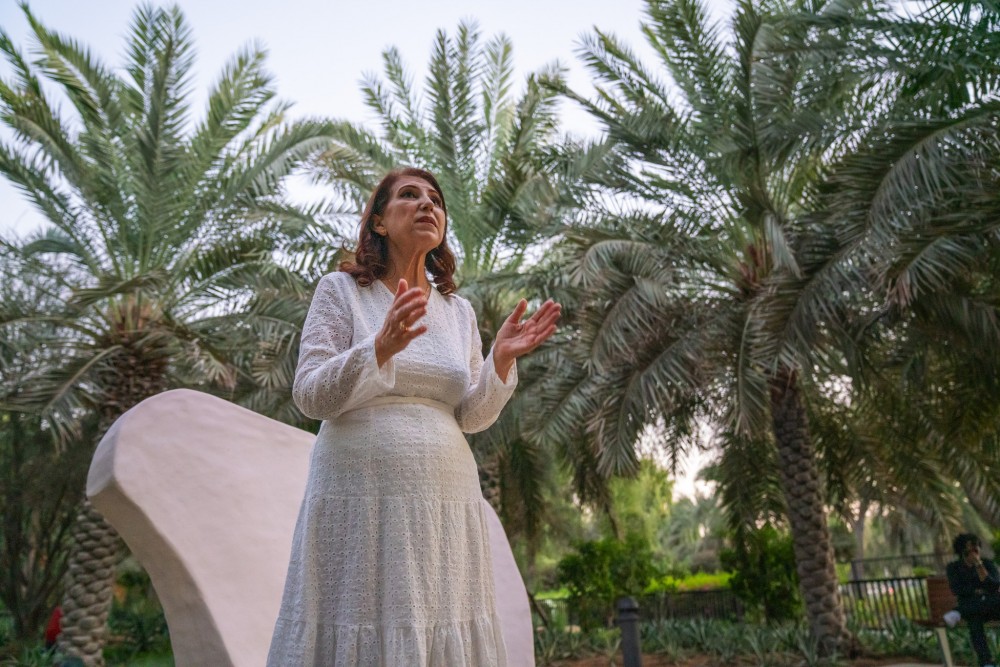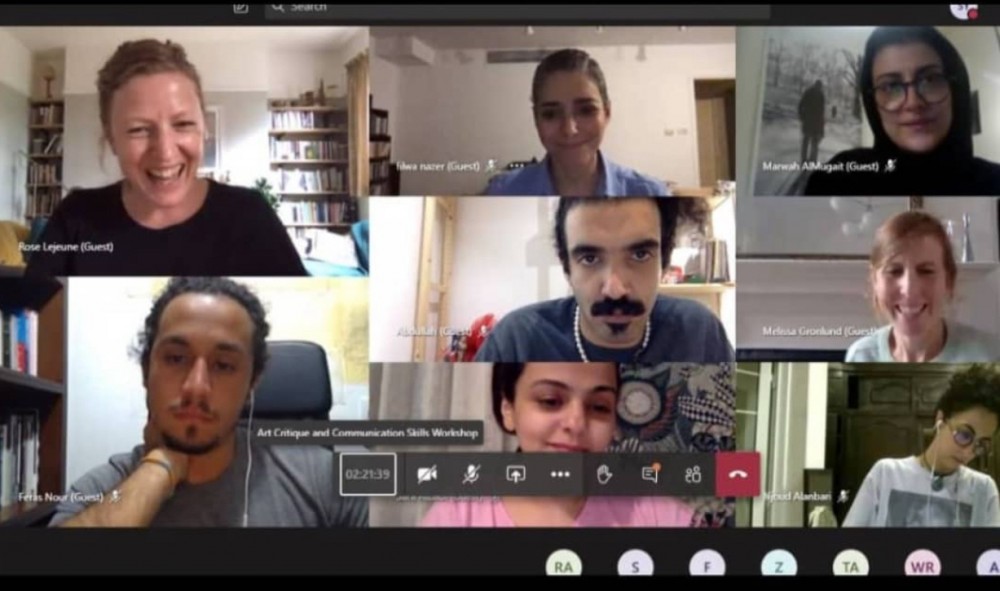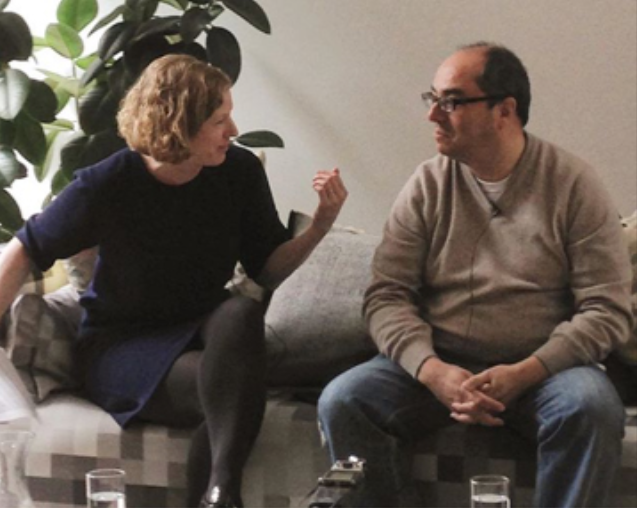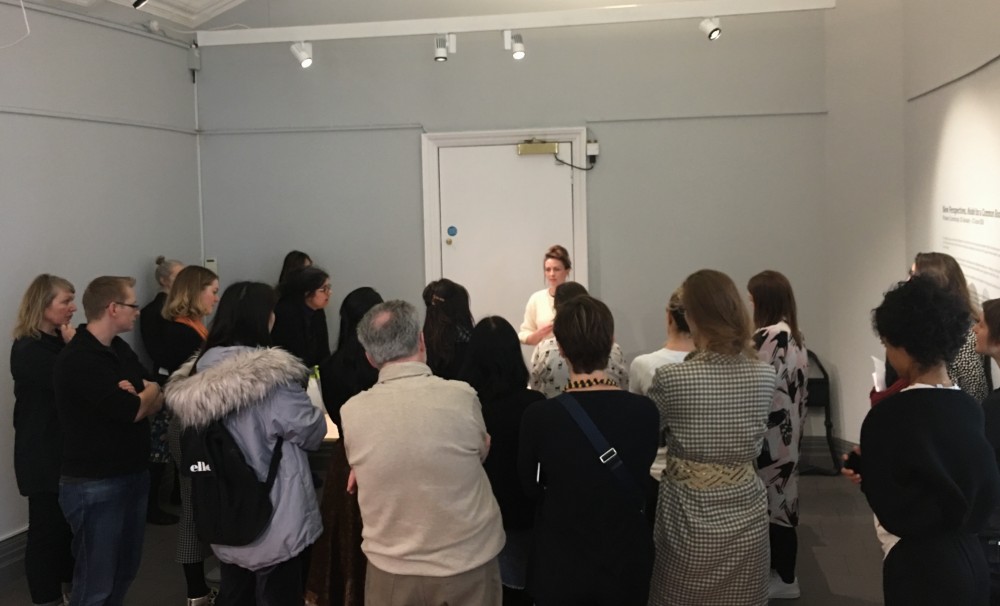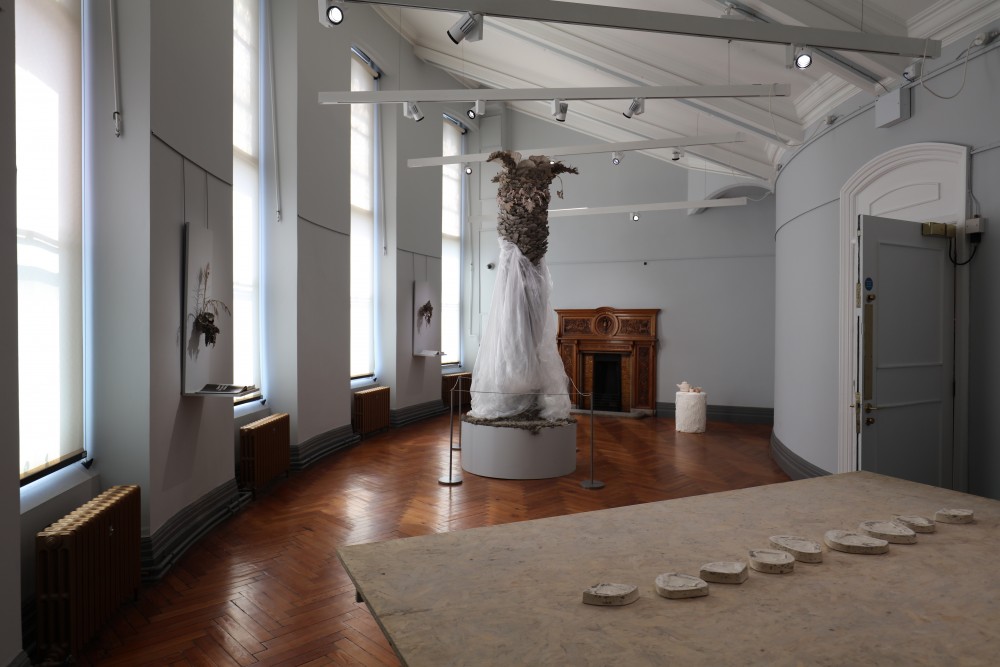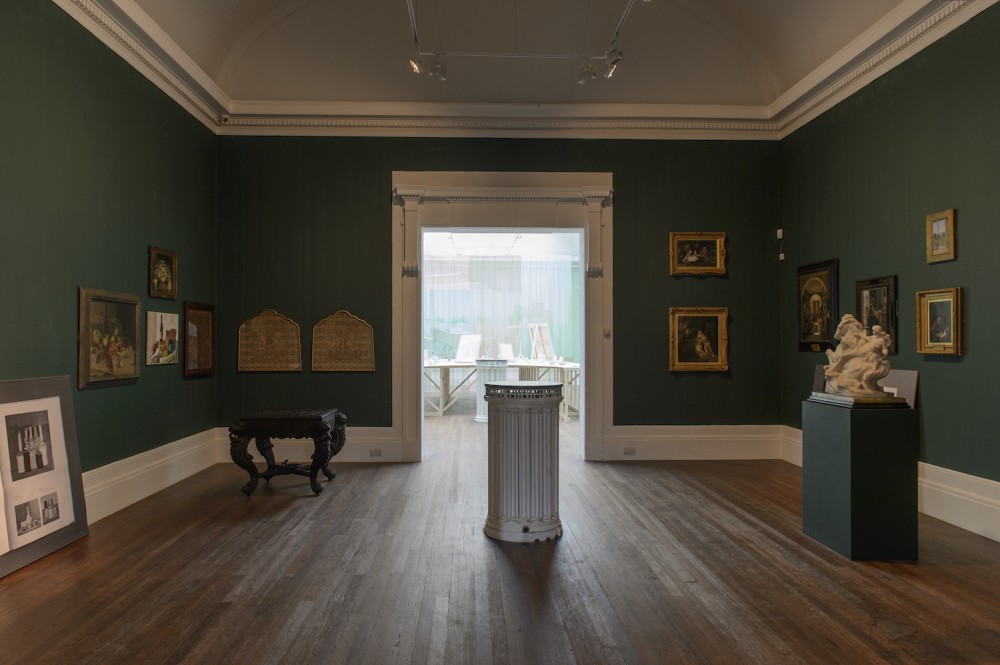Curatorial
Abu Dhabi Art : Live Programme
In 2021 I was invited for the 2nd year to work on the live programme for Abu Dhabi Art.
Through the frame of storytelling and interpretation, this year’s programme entitled ‘The Rocks are Singing to the Stars’, creates a series of journeys through histories, memories and fictions.
The artists use not only live performance, but also sound, sculpture and digital interfaces to create a series of narrative, abstract and poetic experiences within both the fair and the wider landscape of Abu Dhabi itself. Intervening in the urban landscape, they bring its language back into the fair while also transporting audiences into new spaces of reflection and interactions with contrasting space-times and interventions in the fair.
Riffing off participatory experiences such as the tourist’s tour and museum interpretation, these works critically unpick the spaces of art’s display as a social constructs and explore how the audience can be performatively implicated within artworks. Experiences of belonging and displacement, memory and desire ask us to question how the very idea of a live experience is constituted and experienced.
The artists in the programme are Louise Hervé & Clovis Maillet, French artists and Founders of I.I.I.I who explore projections of the future and anthropological knowledge through the language of performance and film; Mays Albaik, Palestinian interdisciplinary visual artist interweaving poetry, socio-politics and geography; Rand Abdul Jabbar, Abu Dhabi-based Iraqi multi-disciplinary artist whose socially-engaged works intersect architecture and visual arts; and Super Taus, Moscow-based artists whose Dagestan cultural origins inform her installation and performance art practice.
In 2020, for an all digital edition of the fair, I was invited to curate the live programme for Abu Dhabi Art. Calling my programme In the Round, I invited four artists – Alice Theobald, Raed Yassin, Nástio Mosquito, and Maitha Abdalla – to each create an 360 degree filmed performance on location in their respective cities of London, Lisbon, Berlin and Abu Dhabi during the summer 2020 lockdown, that would be shown online and as VR projections in Abu Dhabi and London.
The programme brings together artists whose work foreground storytelling and bodies in space to delve into personal histories and our collective imaginaries.
Conceived in a moment of time where gathering together to experience live work was not possible, In The Round offers an experimental way to exhibit artist’s performance within an environment which conceives of the physical and durational immersion of live work within a digital plane
Alice Theobald, Ballad of the Simple Women, 2020 : View the work online here (best watched using the 360 function on a phone).
Raed Yassin, Humming in Abandoned Places, 2020 : View the work online here (best watched using the 360 function on a phone).
Nástio Mosquito, They the Them Are We, 2020 : Not available online.
Maitha Abdalla, Boudoir, 2020 : View the work online here (best watched using the 360 function on a phone).
Consultancy
British Council : Programme Design
As Consultant for Art Criticism and Cultural Skills MENA Region programme, I designed a programme of workshops a that offer professional development and support in creating critical frameworks for artists and curators in Bahrain, Saudi Arabia and Qatar (with Virginia Commonwealth University School of the Arts in Qatar).
Working on the ground, and online through 2020, I lead masterclasses on curating and put together teams of art writers, PR and development specialists and other arts professionals both from the UK and the region to support the development of curating, writing and criticism for international contexts as well as critical discussion frameworks and grassroots development for emerging artists and curators in the region.
Curatorial
Delfina Foundation : Collecting as Practice
I have developed and curated the Collecting as Practice Public Programme at Delfina Foundation since 2017.
Over four seasons, my programme has considered the growing role of collections as spaces for the production, reception and preservation of contemporary art practices. Exploring the potential for collections to re-invent and create cultural histories and public knowledge, the programme seeks to address both the artistic drives behind the impetus to accumulate and rearrange materials and the social potentials for collections in the broadest sense.
Through discussion with artists-in-residence and international collectors, it explores collections as living sites of accumulated knowledge with the potential for critical and active engagement in the development of cultural identity, revisionist histories, and new narratives. This expanded notion understands collections as always embedded and operating in specific social, political, economic, artistic and personal contexts and asks how artists and collectors alike intervene and activate them.
As such, moving beyond a focus on the examination and accumulation of individual art works, the Collecting as Practice Public Programme wishes to energise conversations around artistic and radical collecting methodologies in relation to intimacy and economics, communal ownership, cultural memory and education. In doing so, we hope to unpack how artists and collectors alike are redefining the critical discourses of collecting in a global context.
Season 1 : April – June 2017
Sharing Collections: The first season of Collecting as Practice explored topics including the relationships that are formed between collectors and artists, collecting as a site of encounter which privileges the creation of social relations between people; The social value of private initiatives and museums; ownership of contemporary art and cultural heritage.
Season 2: January – April 2018
De-constructing Collections: The second season of Collecting as Practice explored topics including Artistic interventions and Strategies in Museums; Patronage and Social Change; The Colonial Past and Contemporary International Collecting; Collecting Arab Art: Revising Western Art History Related to the Region and Beyond with Sultan Al Qassemi; Collecting and Supporting Contemporary Art in Morocco
Season 3 : January – April 2021
Restitution and the rights of objects: The third season of Collecting as Practice Delfina Foundation’s brought together international and UK-based creative practitioners to explore the agency of artists and objects, unpacking the ways in which collections are shaped, maintained and framed. Working in collaboration with UK and international institutions, archives and collections, incubating durational research, challenging institutional strategies and laying the foundations for future interventions.
Season 4 : September – December 2021
The life and voice of objects : The fourth season of Collecting as Practice built on the themes from previous Collecting as Practice seasons, grounded in current and urgent debates around representation, restitution and contentious heritage. Using means such as fiction and performativity to unpack histories and violences of colonial collections the residents examine links between ethnographic and natural history collections, disability, environmental and capitalist paradigms; questioning who has the right to categorise, interpret, preserve and propose alternative future lives for objects.
Consultancy
Contemporary Art Society : Programme Report and Study Day
The Contemporary Art Society invited me to write a report on five years of their Collecting Live Art Fund based on a reflection seminar with participating artists and curators, and to put together a Study Day taking inspiration from my both this and my Collecting the Ephemeral programme.
The purpose of the seminar was to reassess the status of collecting performance in museums today; examine a range of case studies and share models of best practice; bring together curators working in public collections to better understand the appetite for collecting performance across the UK; as well as the potential challenges in collecting ephemeral practice.
Speakers included artists Janice Kerbel and Paul Maheke and curators Dr. Sabine Breitwieser and Hugo Worthy.
My report is available on request.
For the study day, I used the opportunity to contextualise collecting live art with the notion of the ‘post-medium collection’ as a starting place to think through ways of collecting that respond to the broad terrain of contemporary art
The title of the the day came from Rosalind Krauss’ definition of the ‘post-medium condition’, an single contemporary art work which includes an enormous variety of material and contextual considerations; multiple media and materials and ideas beyond physical objects. To Krauss’ list we might add the performative, networked and distributed as mediums and modes of presentation.
My keynote for the day argued that despite this, the notion of medium specificity has an ongoing impact within collection frameworks and methodologies. I articulated some of the issues that occur through this mis-match of artistic practice into collection, and explored some curatorial and collecting strategies that approach a new relationship between commissioning, display and collecting of such heterogeneous artistic practices.
The other speakers were Dr Rebecca Gordon, Charlotte Keenan from the Walker Art Gallery, Liverpool, artists Phoebe Cummings and Ludovica Gioscia, and art historian and philanthropist Sarah Elson.
Curatorial
Collecting the Ephemeral : Victoria Museum, Liverpool
Collecting the Ephemeral was an umbrella term I used for a series of commissions and acquisitions I initiated within museums and private collections around the UK between 2015 and 2018.
The commissions explored ways in which artists whose work is inherently process-based, live or participatory can interact with and be incorporated into collections.
For the Victoria Museum, I developed three new exhibitions, each took inspiration from a part of the Museum’s collection or the history of the building itself.
1. Phoebe Cummings – Model for a Common Room
Model for a Common Room takes the idea of a ‘common room’ and its design as the starting point, exploring what activity and functions (practical, intellectual and even decorative) a common space might have, and what possibilities a shared approach to making might offer.
The room in which the work is made was formerly a Women’s Common Room. The first purpose build women’s University education space in country. What remains intact from that time is a fire place, designed and carved by a group of female students; a quietly radical object.
Made entirely from raw clay, the work is a temporary imagining of the room, and will be added to during the exhibition through public workshops and events that invite participation in the making process.
2. Ben Judd : The Part Versus the Whole
Combining an eclectic mix of materials from the Victoria Gallery and Museum’s collections and archives, including historic magic lantern slides and the archeological photography of John Garstang, with new objects, performance and film, the installation brought together threads of mythology with imagined and real histories of characters and architecture from the local environment to create an immersive installation.
The exhibition was experienced while listening to the text written by writer and collaborator David Hering which imagines traces of this lost community’s ghost culture.
3. Open Music Archive feat. 51 Architecture : Play it Again! Use it Together
Eileen Simpson and Ben White’s project takes as its starting point the University of Liverpool’s Institute of Popular Music (IPM) archive of over 80,000 records, an exceptional and rich research resource gifted over a number of years by collectors and enthusiasts.
With a particular focus on copyright-expired hit records from the 1920s, 30s, 40s and 50s, the artists temporarily re-houses the IPM archive in one of the galleries at the Victoria Gallery & Museum for the duration of the exhibition, making it accessible and public for the first time.
Alongside this uncovering of the archive, at the centre of the exhibition was a newly commissioned and bespoke booth created for archive digitisation, broadcast and remix performance, designed with 51 Architecture, the award winning architecture practice led by Catherine du Toit and Peter Thomas. Animated by University of Liverpool and Liverpool John Moores University students and graduates, the exhibition space has be turned into a production site through which the shellac and vinyl records will be digitised and made available online (www.playitagainuseittogether.com). To further explore the usefulness of the public domain digital samples created during the digitisation process, the artists invite a number of collaborators to live produce new music sampling from the evolving public resource.
Consultancy
University of Salford Art Collection : Strategic Review
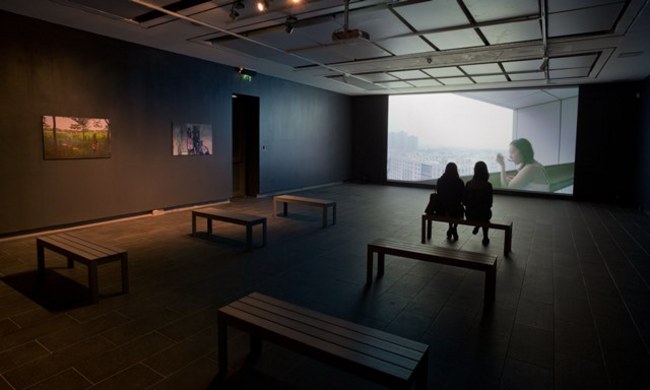
Cao Fei : Haze and Fog (2013) - University of Salford collection at the Centre for Chinese Contemporary Art, Manchester (photo: Paul Hermann)
I was invited by University of Salford Art Collection to undertake a strategic review of its collecting methods and priorities. Through a series of workshops with professional peers, we critically reviewed the current strategy and explored it in relation to the wider contexts of University, national and international collecting.
Through an attention to the specific priorities of the existing University of Salford Collection Development Policy: Chinese Contemporary Art, About the Digital and From the North, the workshops discussed the purpose, value and curatorial methodologies of the University Collection in relation to:
- Acquisition strategies for experimental contemporary art
- Collecting and presenting in the current Higher Education climate
- Collecting and the art market
- The specific challenges and opportunities presented by the Collection’s lack of a dedicated gallery space for permanent display
In order to benefit from external views and wider expertise, and ground the Collection within in the broader context of contemporary collecting, each workshop invited of a selection of colleagues with extensive and varied experience of: national museums, HEI Collections, commercial galleries, private collections, practicing artists and funding.
Each of the workshops explored in turn;
- The rationale for the specific collecting strands
- The commissioning and display partnerships
- The relationships with artists and other key partners
- The part in the relation to the whole and the integrity of the whole
- The visibility of the Collection and its individual artworks
- The curatorial expertise of the Collection’s team
- Possible futures for the Collection
Key findings from the review are available on request.
Curatorial
Collecting the Ephemeral : Grundy Museum and Art Gallery, Blackpool
Collecting the Ephemeral was an umbrella term I used for a series of commissions and acquisitions I initiated within museums and private collections around the UK between 2015 and 2018.
The commissions explored ways in which artists whose work is inherently process-based, live or participatory can interact with and be incorporated into collections.
The first of these projects was Ben Cain – Companions : a substantial new body of work for a solo exhibition responding to permanent works housed by the Grundy Museum and Art Gallery, Blackpool.
Selecting sixteen paintings and objects from the collection, Cain has worked with locally-based artists and craftspeople to have those works, and objects from within the paintings fabricated and introduced into the gallery as new sculptures alongside the original images. In this way, a vase in a painting is rendered into three-dimensional porcelain by a potter, or an amber glass necklace worn by a sitter in the original work is fashioned into being by a glassblower.
The new works and the originals will each be exhibited on specially-constructed stages or raised plinths, which could also be thought of as workbenches. Each plinth will collectively present a scene, as though a large, three-dimensional still-life composed from the collection itself, and the re-worked details from the collection.
The fabrications exist in an ambiguous relationship with the original paintings – on the one hand they render them into the present, creating new narratives from the originals, whilst on the other they are pretenders, fakes and imposters, illicitly inserting themselves into the collection.
The newly made objects could be considered as ‘approximations’ rather than exact copies, acting simultaneously as prototypes, dummies or sketched re-workings forged through collaboration with others, offering casts that are open to interpretation and re-interpretation by audiences of today and tomorrow.
In this way, Cain’s commission examines the process of making an artwork. Items are selected, redrawn, revisited, borrowed, rejected and worked up before the final form emerges. Frequently, attempts that are set aside are nevertheless indispensable parts of a work’s development.
Companions continues Cain’s long-running investigations into the themes of material, labour, and artistic production. The exhibition is inspired by the Grundy collection itself, which is made up of an eclectic mix of items from paintings to jewelry to ornaments and furniture accumulated over the years, frequently with little known provenance. The commission responds to the character of a museum collection as a group of objects housed in one place over the course of time, offering a way to move between the image’s content, the context within which they were made and the present and future moments of their viewing.
